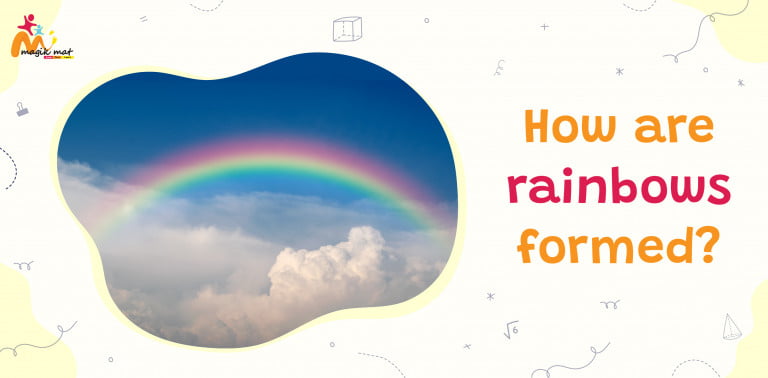Introduction:
Have you ever been amazed by the beauty of a rainbow? Maybe you’ve even tried to track one down to see where it goes. While most of us have witnessed a rainbow at some point in our lives, many of us are unaware of the science behind its formation. In this blog, you will learn about how rainbows are formed and go into the science. So, sit back, relax, and learn the secrets of the rainbow. So, sit back, relax, and learn the secrets of the rainbow.
What is a Rainbow?
A rainbow is a climatic phenomenon that appears in the sky as a multicoloured arch. It is caused by the reflection, refraction, and dispersion of sunlight in the Earth’s atmosphere by water droplets. Rainbows usually appear when the sun is shining, and rain is falling simultaneously. This causes the sunlight to separate into its component colours, creating the characteristic arc of colours that we see in the sky. Rainbows have many colours but only seven are visible to the naked eye. The colours of the rainbow appear in a specific order: red, orange, yellow, green, blue, indigo, and violet. The phrase “ROYGBIV” is often used to remember this order because each letter stands for the initial letter of each colour (R for Red, O for Orange, etc.) Rainbows can also appear in other situations, such as near waterfalls, fountains, or mist, but the most common type of rainbow is caused by sunlight and rain.
How does the sky make a rainbow?
When sunlight enters a raindrop, it is refracted, or bent, at a certain angle. This causes the white light to be separated into its component colours, which are then reflected inside the raindrop and refracted again as they exit. The colours are then spread out in a circular arc, with red on the outer edge and violet on the inner edge. This is what creates the beautiful rainbow that we see in the sky.
When and where do we see a rainbow?
Rainbows can be seen in any location where there is rain and sunshine at the same time. However, there are some factors that affect when and where a rainbow is visible. The most important of these factors are the position of the sun, the presence of rain, and the observer’s location.
Rainbows can only be seen when the sun is behind the observer and rain is in front of the observer. The best time to see a rainbow is in the late afternoon or early evening, when the sun is low on the horizon and the light is more likely to be refracted by raindrops. Rainbows are also more likely to be visible in areas with a lot of moisture in the air, such as near bodies of water or in humid climates.
The rainbow will appear as an arc in the sky, with the colours red, orange, yellow, green, blue, indigo, and violet. The colours are always in the same order, with red on the outside and violet on the inside.
Types of Rainbows:
Double Rainbow:
A Double rainbow is a meteorological phenomenon that consists of two rainbows that appear simultaneously in the sky. The primary rainbow is brighter and more visible, while the secondary rainbow is thinner and appears above it. This occurs when light is refracted twice within raindrops, creating a second internal reflection.
Double rainbows are often considered to be a symbol of good luck or a sign of hope. They have been referenced in literature and art for centuries and continue to captivate people with their beauty and rarity.
Moonbow:
A moonbow is a rainbow that is created by moonlight rather than the sun. It can also be referred to as a moon rainbow or lunar rainbow.
A moonbow, is a rare atmospheric phenomenon that occurs at night when moonlight refracts and reflects off water droplets in the air, resulting in the formation of a thin, spectral rainbow. Moonbows are usually visible to the naked eye during full moon nights when the moon is bright enough. They are often seen near waterfalls or other sources of mist or spray, which provide the necessary water droplets for the moonlight to refract off. Moonbows are a beautiful and magical sight and are a rare treat.
Fogbow:
A fogbow is a rare meteorological phenomenon that looks like a white or colourless rainbow. It forms when sunlight is diffracted by tiny water droplets in fog or mist rather than raindrops as in a regular rainbow. In contrast to a rainbow, the colours of a fogbow are usually light or non-existent, and the centre is usually brighter than the edges. Fogbows are also known as white rainbows, cloud bows, ghost rainbows, and seadogs. They are most observed in early morning or late afternoon when the sun is low in the sky, and the fog or mist is dense.
Reflection Rainbow:
A reflection rainbow is a result of the reflection of a primary rainbow by the water. It appears above the primary rainbow and is centred opposite the sun at the same elevation angle. Reflection rainbows are seen over smooth water surfaces like lakes, calm seas, and quiet coastal waters where sunlight is reflected upwards. Both primary and secondary reflection rainbows can have their light source in the sunlight that is reflected. The centre of a typical rainbow would be below the horizon at this altitude, but reflection bows appear in the sky at a higher elevation near the horizon.
Monochrome Rainbow:
When a rainbow’s colour spectrum is purely based on one colour, it is said to be monochromatic. A monochromatic rainbow is also referred to as a red rainbow. It is a phenomenon that occurs when sunlight is refracted and reflected in water droplets in the atmosphere, the difference is that for a monochromatic rainbow, the sun must be near the horizon, that is, at sunrise or sunset. The sun’s low angle causes its light to travel longer through the atmosphere, dispersing shorter wavelengths of light like blue, green, and yellow and leaving mostly red. A monochromatic rainbow can have a very dramatic impact in the lower light environment where the phenomenon forms most frequently.
Reflected Rainbow:
Reflected rainbows occur when sunlight reflects off a body of water, such as a lake or pond, and then passes through water droplets in the air, creating a second rainbow that appears upside down compared to the primary rainbow.
Unlike primary rainbows, which form a full circle, reflected rainbows only appear in a portion of a circle, with their endpoints meeting in an almond-shaped pattern. This is because the angle of reflection off the water surface is different than the angle of refraction through the water droplets in the air. Reflected rainbows can be a beautiful sight to behold and are often seen in nature around bodies of water.
Conclusion:
Overall, rainbows are a fascinating and interesting natural phenomenon that remind us of the beauty and wonder of the world around us. So next time you see a rainbow, take a moment to appreciate its colours and the scientific principles that create it, as well as the cultural and symbolic meanings that it holds.
FAQ’s:
* Name the seven colours of Rainbow?
The colours of the rainbow in order are:
Red, Orange, Yellow, Green, Blue, Indigo, Violet.
* What is secondary rainbow?
Secondary rainbow is formed by two internal reflections within each water droplet, rather than just one as in the case of a primary rainbow. This results in a reversed colour sequence with red on the inner edge and blue on the outer edge of the arc.
The secondary rainbow appears above the primary rainbow and has a larger radius, making it less distinct and more difficult to observe. It is also generally dimmer than the primary rainbow due to the additional reflection and refraction of light within the water droplets.





